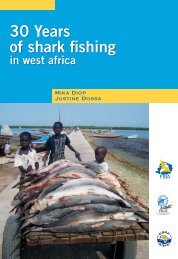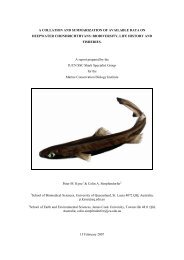Magazine of the species survival Commission specialist Group - IUCN
Magazine of the species survival Commission specialist Group - IUCN
Magazine of the species survival Commission specialist Group - IUCN
Create successful ePaper yourself
Turn your PDF publications into a flip-book with our unique Google optimized e-Paper software.
<strong>specialist</strong> group exchange<br />
Chameleon also emphasizes <strong>the</strong><br />
importance <strong>of</strong> implementing<br />
conservation activities on <strong>the</strong> Seychelles.<br />
Richard Jenkins<br />
Chair, Chameleon Specialist <strong>Group</strong><br />
Conservation<br />
Breeding SG<br />
Red Panda Population and Habitat<br />
Viability Assessment<br />
Concern has been growing that a<br />
serious decline <strong>of</strong> <strong>the</strong> Red Panda<br />
(Ailurus fulgens) across its range is<br />
likely. Concrete data are lacking,<br />
however, as are action plans directed<br />
specifically to <strong>the</strong> ga<strong>the</strong>ring <strong>of</strong> missing<br />
information and <strong>the</strong> mitigation <strong>of</strong> threats<br />
to this <strong>species</strong> and its habitat. For <strong>the</strong>se<br />
reasons, <strong>the</strong> <strong>IUCN</strong> SSC Conservation<br />
Breeding Specialist <strong>Group</strong> (CBSG) was<br />
invited to conduct a Population and<br />
Habitat Viability Assessment (PHVA) for<br />
<strong>the</strong> Red Panda in Nepal.<br />
The workshop was organized by <strong>the</strong><br />
Government <strong>of</strong> Nepal, Department <strong>of</strong><br />
National Parks and Wildlife, Department<br />
<strong>of</strong> Forest, <strong>the</strong> NTNC, CBSG South Asia<br />
and WWF, and facilitated by a joint<br />
team <strong>of</strong> CBSG South Asia and CBSG<br />
Europe. Funding was provided by WWF<br />
Germany, Rotterdam Zoo and members<br />
<strong>of</strong> <strong>the</strong> European Association <strong>of</strong> Zoos<br />
and Aquariums (EAZA). This was one <strong>of</strong><br />
<strong>the</strong> first PHVAs to incorporate <strong>the</strong><br />
visioning component <strong>of</strong> <strong>the</strong> <strong>IUCN</strong> SSC<br />
Species Conservation Strategy<br />
approach. The 60 delegates, including<br />
representatives <strong>of</strong> three range countries<br />
– Nepal, Bhutan and India – envisioned<br />
a future for Red Pandas in Nepal <strong>of</strong>:<br />
“Secure, viable populations distributed<br />
in contiguous natural habitat throughout<br />
<strong>the</strong> Himalaya regardless <strong>of</strong> national<br />
boundaries where this flagship <strong>species</strong><br />
brings benefits to <strong>the</strong> region and is<br />
valued and protected by all<br />
stakeholders”.<br />
GIS technology was used to map<br />
<strong>the</strong> confirmed and possible occurrence<br />
<strong>of</strong> Red Pandas in Nepal. Eleven<br />
subpopulations were identified holding<br />
in total an estimated 230 to 1,060<br />
individuals. A computer model helped<br />
to establish that <strong>the</strong> majority <strong>of</strong> <strong>the</strong><br />
subpopulations are so small that <strong>the</strong>y<br />
have a high probability <strong>of</strong> extinction,<br />
even in <strong>the</strong> absence <strong>of</strong> human threats.<br />
Larger subpopulations also have a high<br />
risk <strong>of</strong> extinction in <strong>the</strong> short- to<br />
medium-term if current levels <strong>of</strong> threat<br />
persist. Taking into account all <strong>the</strong><br />
information ga<strong>the</strong>red in <strong>the</strong> meeting,<br />
participants identified and prioritized <strong>the</strong><br />
threats, and developed goals,<br />
objectives and concrete actions. These<br />
actions will provide <strong>the</strong> first steps<br />
towards achieving <strong>the</strong> vision for this<br />
flagship <strong>species</strong> <strong>of</strong> <strong>the</strong> Himalaya.<br />
Virginia Lindgren<br />
Member, Conservation Breeding<br />
Specialist <strong>Group</strong><br />
Crocodile SG<br />
Caiman conservation<br />
The 20th biennial Working Meeting <strong>of</strong><br />
<strong>the</strong> <strong>IUCN</strong> SSC Crocodile Specialist<br />
<strong>Group</strong> (CSG) was held in Manaus,<br />
Brazil, on 13–17 September 2010,<br />
involving some 200 people from 26<br />
countries. Since <strong>the</strong> first meeting in<br />
1971, <strong>the</strong>se working meetings have<br />
been <strong>the</strong> central forums in which<br />
crocodilian conservation action around<br />
<strong>the</strong> world has been initiated for nearly<br />
Red Panda (Ailurus fulgens). © Dave Pape<br />
18 • <strong>species</strong> 52
















